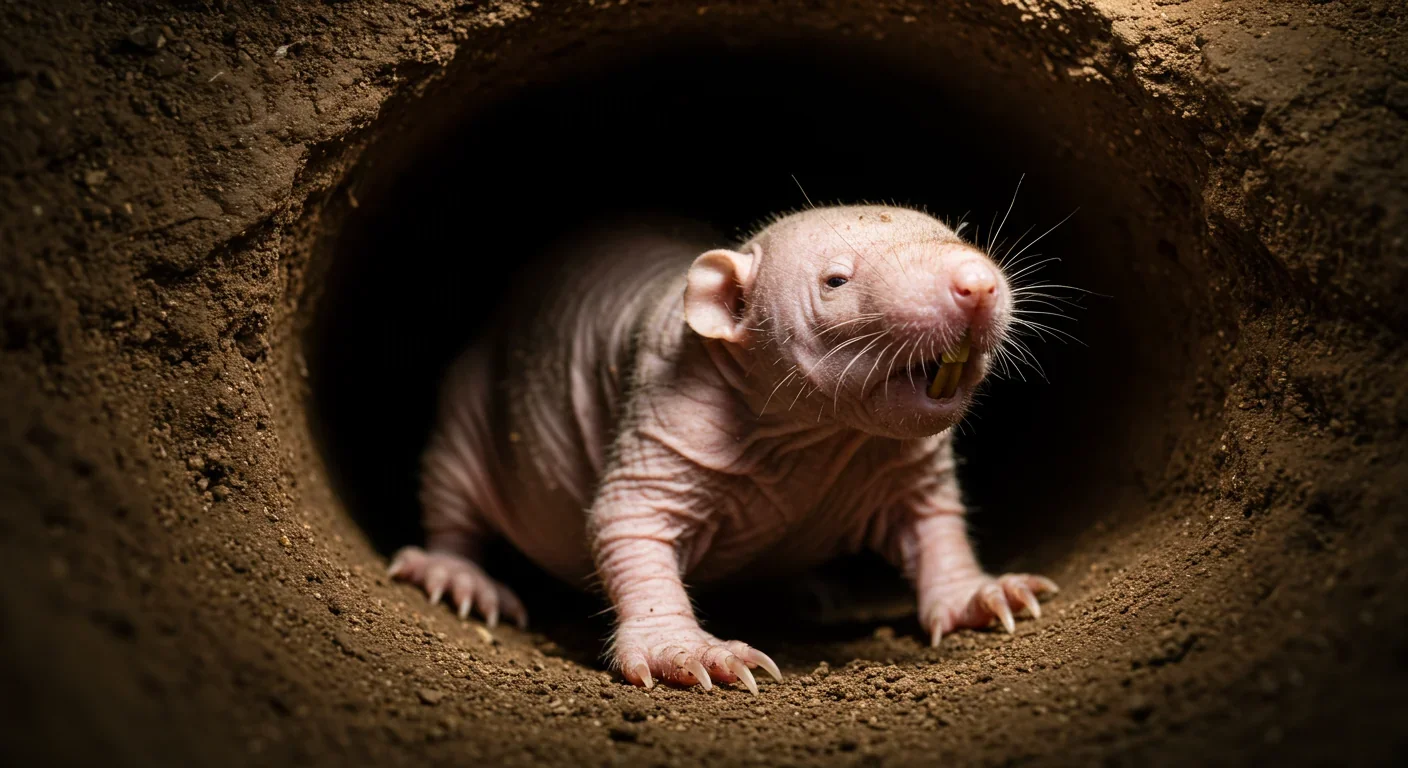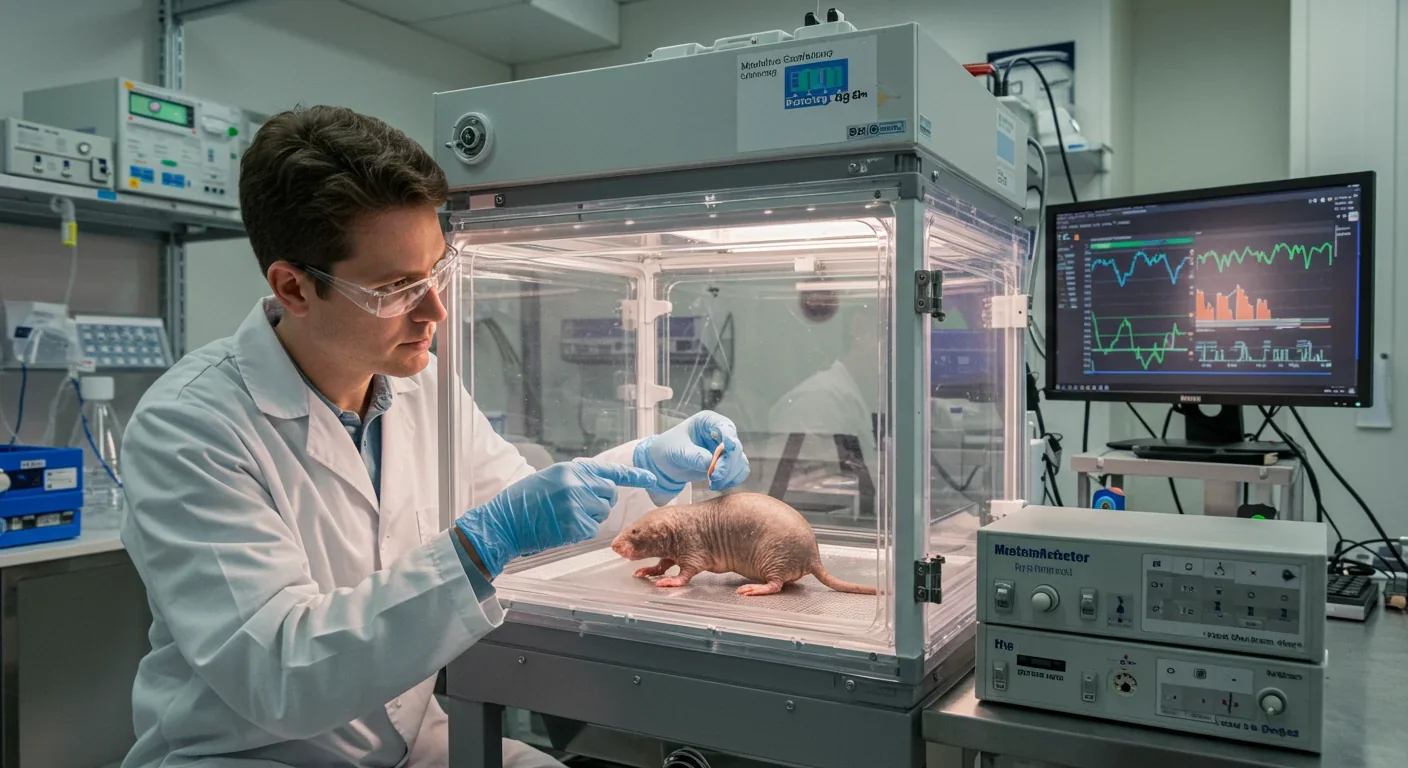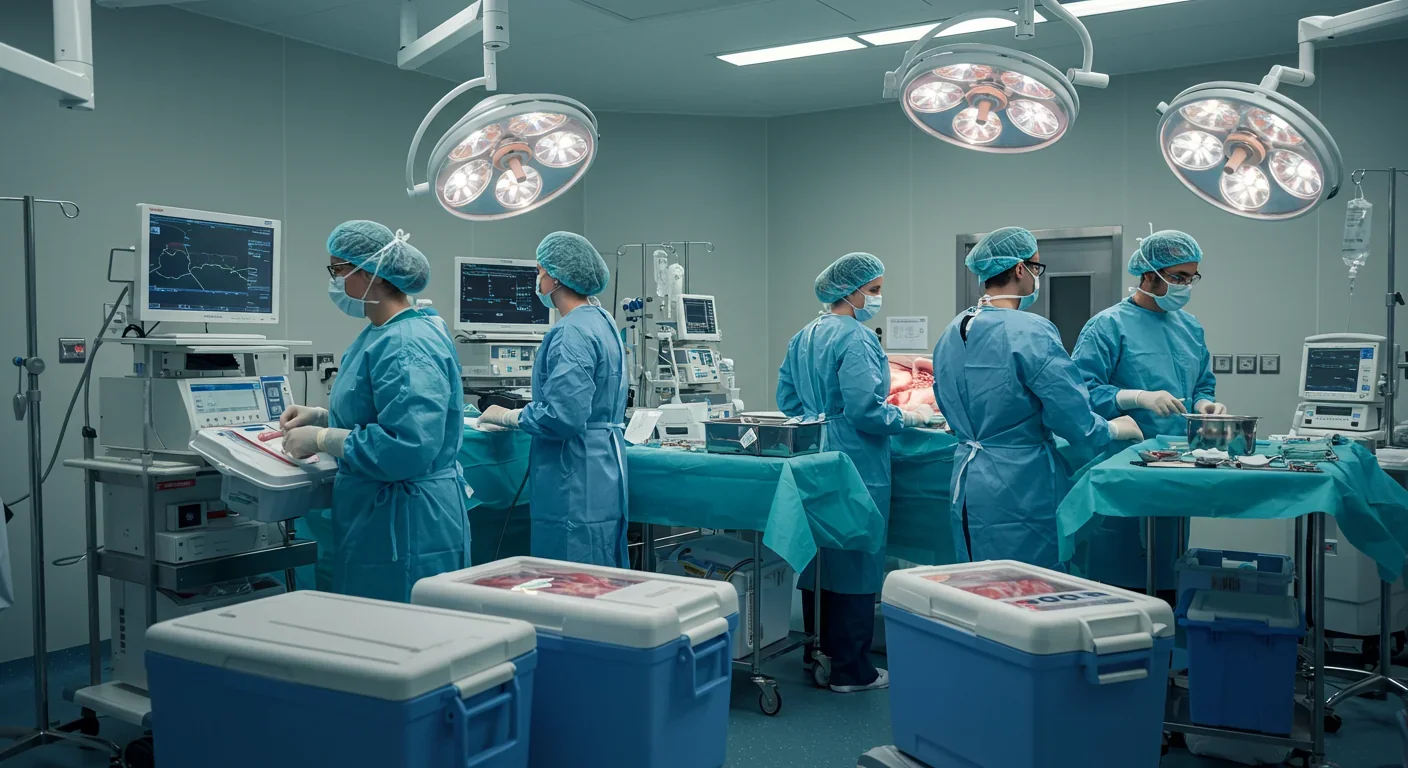Plants and Microbes: Nature's Solution to Toxic Soil

TL;DR: Naked mole rats survive 18 minutes without oxygen by switching from glucose to fructose metabolism—a plant-like superpower that could revolutionize stroke treatment and organ transplantation.

In an underground tunnel somewhere in East Africa, a pink, wrinkled creature the size of a mouse has just done something no other mammal can do: it's stopped breathing. Not gasping, not struggling—just stopped. Eighteen minutes later, it wakes up as if nothing happened. While human brains die after just four to five minutes without oxygen, the naked mole rat has cracked a code that's rewriting what we thought possible for mammalian life.
This isn't science fiction. It's one of nature's most extreme solutions to an everyday problem, and it could revolutionize how we treat strokes, heart attacks, and even how long we can keep organs viable for transplant.
Here's where it gets weird. When oxygen levels plummet, naked mole rats do something unprecedented in mammals: they switch their entire metabolism to run on fructose instead of glucose. It's a metabolic pathway we've only seen in plants.
Think of it like a hybrid car seamlessly switching from gasoline to electric when the tank runs dry, except this switch happens at the cellular level and involves rewriting the fundamental rules of mammalian biology. The naked mole rat releases massive amounts of fructose into its bloodstream during oxygen deprivation, then shuttles it directly to the brain using specialized transporters called GLUT5. These fructose pumps, normally found only in our intestines, somehow made their way into naked mole rat brain cells.
Once there, the fructose feeds into anaerobic glycolysis—a way to generate energy without oxygen. While other mammals suffocate, these rodents enter what researchers call a "suspended animation-like state." Heart rate drops, breathing stops, they lose consciousness. But unlike a human in cardiac arrest, they wake up minutes later with zero brain damage.
At the University of Illinois at Chicago, researcher Thomas Park exposed naked mole rats to conditions that would kill a human in minutes. The animals didn't just survive—they thrived for up to five hours in severely low oxygen, and endured 18 minutes of complete anoxia.
So how did a mammal develop a superpower normally reserved for plants? The answer lies hundreds of feet underground.
Naked mole rats live in massive colonies—sometimes over 300 individuals crammed into tunnel systems spanning the length of several football fields. The ventilation is terrible. With that many warm bodies breathing in poorly ventilated tunnels, carbon dioxide levels can spike to 10 percent, and oxygen levels plummet accordingly.
For most mammals, this would be a death trap. But for naked mole rats, it's home. Over millions of years, the ones who could tolerate these hypoxic episodes lived long enough to reproduce. The ones who couldn't, died. Natural selection, working at its most brutal, crafted a metabolic Swiss Army knife.
The evolutionary pressure was relentless and specific: survive oxygen deprivation or die out. The solution? Co-opt pathways that already existed in mammalian cells but were suppressed or restricted to other tissues. Those intestinal fructose transporters got expressed in the brain. Enzymes that normally process dietary fructose were repurposed for emergency energy production.
What's remarkable is how elegant the solution is. As Jane Reznick, a molecular biologist studying these animals, put it: "Everything seems to be contradictory, but then you slowly get this very surprising but quite elegant solution."

When oxygen levels drop, a naked mole rat doesn't panic. Its body initiates a highly controlled metabolic shift that looks more like a planned power-down than a crisis.
The process is reversible. That's the crucial part. Within seconds of oxygen returning, breathing resumes and heart rate normalizes. There's no frantic gasping, no permanent neurological damage, no cellular destruction from reperfusion injury—the kind that devastates human stroke and heart attack patients when blood flow suddenly returns.
Recent research has uncovered even more intricate mechanisms at work. Naked mole rat hearts express a liver-specific enzyme called amylase, typically used for digesting starch. During oxygen deprivation, this enzyme rapidly activates and breaks down glycogen stores more efficiently than standard mammalian metabolism allows. It's as if they've borrowed the metabolic playbook from multiple organs and tissues, creating a hybrid system optimized for hypoxic survival.
The animals also maintain higher ATP levels—the cellular energy currency—during ischemic conditions. Unlike humans, whose hearts are devastated by oxygen loss, naked mole rat hearts actually show enhanced energy reserves during simulated heart attacks.
Here's why stroke neurologists and cardiac surgeons are paying attention: the pathways enabling this metabolic switch already exist in human cells. They're just dormant.
"The necessary genetic pathways for the heart and brain to burn fructose are present in all mammalian cells—including ours," explains Gary Lewin, a neurobiologist working on translational applications. "Metabolism is relatively plastic, so it may be possible to find ways—genetically introducing a transporter, or using a drug to train cells—to push human cells in the direction of metabolizing fructose."
The implications span multiple medical crises. During a stroke, brain cells die within minutes because oxygen-starved neurons can't produce energy. But what if we could flip that metabolic switch, even temporarily? Researchers envision a future where high-risk patients could be primed with drugs that activate these dormant fructose-processing enzymes. Then, if a stroke or heart attack occurs, a quick injection of fructose could buy crucial time—expanding the window for intervention from minutes to potentially hours.
For organ transplantation, the potential is equally transformative. Right now, organs deteriorate rapidly once removed from the body because cells can't survive prolonged oxygen deprivation. If we could trigger the same protective metabolic state naked mole rats enter naturally, we might extend the viability window dramatically, saving thousands of lives currently lost to timing and logistics.
The hypoxia tolerance is just one item on a growing list of naked mole rat superpowers that seem biologically impossible.
These animals are virtually immune to cancer. While lab mice reliably develop tumors, naked mole rats possess a unique form of hyaluronan—a molecule that prevents cells from clumping together, one of the first steps in tumor formation.
They don't feel pain the way other mammals do. Acid that would send a mouse into agony barely registers. They've modified pain receptors to be insensitive to certain stimuli, likely because underground tunnels accumulate acidic carbon dioxide.
Most striking of all: they live over 30 years. That's roughly ten times longer than a mouse of similar size. They don't show typical signs of aging—no increased cancer rates, no cardiovascular decline, no loss of reproductive capacity. They seem to have beaten aging itself.
The convergence of these traits suggests something profound: these animals have fundamentally rewired mammalian biology. And each superpower likely connects to the others through shared metabolic pathways.

Naked mole rats aren't the only animals that can survive extreme oxygen deprivation, but their strategy is unique among mammals.
Seals and whales can hold their breath for hours, but they're not experiencing anoxia—they're storing massive amounts of oxygen in their blood and muscles, then carefully rationing it. Painted turtles can survive months frozen in ice with no breathing, but they're cold-blooded and can enter genuine suspended animation by slowing their metabolism to nearly zero.
What makes naked mole rats special is that they're warm-blooded mammals—like us—yet they've evolved an active metabolic workaround rather than just rationing existing oxygen or shutting down completely. They're producing energy through a completely different chemical pathway, one that doesn't require oxygen at all.
This distinction matters for medical applications because humans share far more biology with naked mole rats than with seals or turtles. The genetic and metabolic machinery is more directly translatable.
The 2017 study that revealed the fructose-switching mechanism—published in the journal Science—opened a floodgate of research. Labs worldwide are now dissecting the molecular signals that trigger the switch, mapping which genes turn on and off, and testing whether similar pathways can be activated in human cells.
There are still major questions. Where does all that fructose come from? Do naked mole rats produce it during oxygen deprivation, or is it stored somewhere in the body? What are the upstream signals that sense dropping oxygen levels and initiate the cascade? Can we find a drug that mimics those signals in humans?
Some researchers worry about unintended consequences. Fructose metabolism in humans is already controversial because excessive dietary fructose contributes to metabolic syndrome and fatty liver disease. But the context here is entirely different—we're talking about temporary metabolic shifts during acute medical emergencies, not chronic dietary exposure.
Others point out that even if we crack the science, translating it to clinical use will take years of testing. Regulatory approval for metabolic interventions is notoriously slow, and the stakes are incredibly high when dealing with stroke and cardiac arrest patients.
Still, the potential is too enormous to ignore. Every year, millions of people suffer strokes and heart attacks. Thousands die waiting for organs. If naked mole rat biology can teach us even one new trick—expanding the therapeutic window by even ten extra minutes—we could save countless lives.
This research forces us to reconsider the boundaries of what's biologically possible.
For decades, textbooks taught that mammals must use glucose for energy and require oxygen for survival beyond a few minutes. Naked mole rats shatter both assumptions. They demonstrate that evolution can produce radical solutions when the selective pressure is strong enough, and that the genetic toolkit for these solutions might already exist in dormant form across many species.
The discovery also underscores how much we still don't understand about life's possibilities. These animals were scientifically described over a century ago, but we're only now unraveling their full biological toolkit. What other creatures are out there, hiding capabilities we haven't yet discovered?
In a way, the naked mole rat embodies the best of biological research: taking something weird from nature and asking not just "how does this work?" but "what can this teach us?" The answers might just transform medicine as we know it.
For now, these wrinkly, buck-toothed rodents continue their lives in underground tunnels, blissfully unaware that they're rewriting the rules of mammalian physiology. And somewhere, a researcher is watching them, wondering what other impossible feats they might reveal.

Curiosity rover detects mysterious methane spikes on Mars that vanish within hours, defying atmospheric models. Scientists debate whether the source is hidden microbial life or geological processes, while new research reveals UV-activated dust rapidly destroys the gas.

CMA is a selective cellular cleanup system that targets damaged proteins for degradation. As we age, CMA declines—leading to toxic protein accumulation and neurodegeneration. Scientists are developing therapies to restore CMA function and potentially prevent brain diseases.

Intercropping boosts farm yields by 20-50% by growing multiple crops together, using complementary resource use, nitrogen fixation, and pest suppression to build resilience against climate shocks while reducing costs.

The Baader-Meinhof phenomenon explains why newly learned information suddenly seems everywhere. This frequency illusion results from selective attention and confirmation bias—adaptive evolutionary mechanisms now amplified by social media algorithms.

Plants and soil microbes form powerful partnerships that can clean contaminated soil at a fraction of traditional costs. These phytoremediation networks use biological processes to extract, degrade, or stabilize toxic pollutants, offering a sustainable alternative to excavation for brownfields and agricultural land.

Renters pay mortgage-equivalent amounts but build zero wealth, creating a 40x wealth gap with homeowners. Institutional investors have transformed housing into a wealth extraction mechanism where working families transfer $720,000+ over 30 years while property owners accumulate equity and generational wealth.

AlphaGo revolutionized AI by defeating world champion Lee Sedol through reinforcement learning and neural networks. Its successor, AlphaGo Zero, learned purely through self-play, discovering strategies superior to millennia of human knowledge—opening new frontiers in AI applications across healthcare, robotics, and optimization.